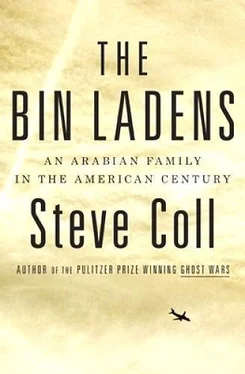In Koranic tradition, Abraham is credited as the Ka’ba’s creator. In this account, while visiting his son Ishmael in Mecca, God ordered Abraham to build a temple devoted to His oneness. As Mohamed received his revelations, he preached for the restoration of Abraham’s plan. His sermons provoked resistance from Meccan tribal leaders and elders, who seemed to view the Prophet, himself an active businessman, as a sort of anti-capitalist spoiler, one whose ideas could, in particular, ruin their lucrative festival. Meccan opposition forced Mohamed into exile, to the town later named Medina, where he found political support. He prevailed in a series of battles and returned to Mecca in triumph. He entered the Ka’ba and, according to Al-Azraqi, “he asked for a cloth which he soaked in water, and ordered all the pictures to be erased.” With this act Mohamed created an Islamic aesthetic rooted in the eradication of the multihued religious images of his Meccan youth. In the last years of his life Mohamed also announced the detailed new rules of the Hajj, one of the five pillars of the religion that Allah had revealed to him; this annual ritual’s crushing crowds, drawn from around the world, would soon belie the earlier skepticism of Mecca’s festival merchants. 3
Islam expanded from Spain to Indonesia; a succession of dynasties ruled Mecca. Egyptian and Ottoman princes took the Hejaz and managed the Hajj after the thirteenth century. They often did so in a style that recalled the pre-Islamic festivals—there were marching bands and opulent parties, and a conspicuous emphasis on profiteering, which caused the reputation of Meccan merchants to fall so low that fleeced pilgrims referred to them as “the dogs of the Hejaz.” When the Wahhabi movement first rose in the Nejd desert in the late eighteenth century, its warriors saw themselves as purifiers in Mohamed’s name; as the Prophet had done, they would rescue Mecca from idolaters. Theirs was a desert world of parched deprivation and intense kin unity that had rarely been penetrated by other cultures. They shocked Mecca’s cosmopolitan pilgrims:
You must imagine a crowd of individuals, thronged together, without any covering than a small piece of cloth around their waist…being naked in every other respect, with their matchlocks upon their shoulders, and their khanjears or large knives hung to their girdles. All the people fled at the sight of this torrent of men…They had neither flags, drums nor any other instrument or military trophy during their march. Some uttered cries of holy joy, others recited prayers in a confused and loud voice. 4
The Wahhabis destroyed every dome and tomb in the city; their scholars regarded much existing Islamic architecture as heretical, apart from the flat-roofed Ka’ba and mosques constructed in a similar design. Egyptian soldiers eventually drove the Wahhabis away and destroyed their featureless capital in Riyadh, but under the more durable leadership of Abdulaziz, the Islamic militias returned to Mecca in 1924. Again they tore down domes and attacked foreign pilgrims who lingered too long at decorated historical shrines, which the Wahhabis regarded as false temples.
Abdulaziz sought Mecca for its tax receipts and its prestige. He adhered to Wahhabi precepts, but he had no particular interest in the endless scholarly arguments in Riyadh about the status of every last curved roof and revered historical tourist site in his expanding kingdom. As with other aspects of his statecraft, Abdulaziz sought a synthesis: he appeased the Islamic radicals who gave him soldiers and legitimacy, yet he tried not to alienate the Ottoman subjects whom he had inherited. The king’s Wahhabi militias, for instance, wanted to tear down the Prophet’s Mosque in Medina, where Mohamed had preached during his exile; they saw it as a kind of heretical tourist trap. Abdulaziz recognized that its destruction would be deeply unpopular and would also crimp the pilgrim trade. He settled on a compromise in which the Wahhabis were allowed to take off the mosque’s dome but were otherwise required to leave it be, and to accommodate its thronging crowds. As a contemporary traveler put it, the king gained credit from the Wahhabis “for having allowed the dome to be demolished, and credit from the foreign Hajjis for protecting the place from complete demolition.” 5This would become a basis for Saudi management of Mecca and Medina in the ensuing decades. The Wahhabi aesthetic would predominate, but it might, at times, be bent grudgingly to accommodate Islam’s global diversity, particularly in pursuit of pilgrim revenue.
With ownership of the Hejaz came responsibility for the civic upkeep and improvement of Mecca and Medina. Abdulaziz carpeted the Holy Mosque in Mecca in 1928 and paid for a new gold-plated door in 1944, but otherwise, during the sparse years of the Great Depression and the Second World War, he could afford only light renovations. Amid the postwar boom, however, as the number of pilgrims arriving in his kingdom swelled, the king allocated larger sums. His objectives were not decorative but practical: Both the Medina and Mecca mosques were too small to accommodate the number of pilgrims they now attracted, particularly during the peak Hajj season. Jumbled town houses, market stalls, and twisting lanes surrounded both mosques, preventing their expansion. Encouraged by his sons Saud and Faisal, Abdulaziz agreed to remake both the old towns—Medina first, then Mecca. 6
By September 6, 1949, when Abdulaziz published an open letter announcing his redevelopment plan for Medina, Mohamed Bin Laden had established himself as the king’s principal builder. Mecca’s and Medina’s mosques and sacred sites were organized as Islamic trusts, or waqfs , overseen by boards of scholars and Hejazi notables, but a construction contract of this size was the king’s decision, abetted by Suleiman. Bin Laden was their man. He was invited to run the entire Medina project, a lucrative grant that would include the demolition and construction work around the mosque itself, and also a new electrical grid, waterworks, and an airport. An official Bin Laden history, as well as contemporary diplomatic correspondence, suggests the Prophet’s Mosque expansion and renovation project alone cost about $19 million during the early 1950s, not counting the even larger sum spent on compensation to landowners whose property was seized and cleared. 7
The Medina project marked the beginning of the profound architectural and design influence that the Bin Laden family would have on the two holy cities for many years to come. Mohamed Bin Laden brought to the renovation a “modern architectural style,” as his company’s official history put it, involving the heavy use of reinforced concrete and decorative black marble. The brass lamps might be gaudy and the concrete oppressive, but both were certifiably up to date, and thus, during the 1950s, praiseworthy. And not only in Saudi eyes: one contemporary Lebanese visitor called the architecture Bin Laden oversaw “an impressive and luxurious piece of work.” When his redesign was completed in 1955, about two years after the death of Abdulaziz, Bin Laden had constructed more than seven hundred new pillars in the Prophet’s Mosque, as well as a similar number of concrete arches. He had added nine gates, two gravel squares for worshippers, and forty-four windows; altogether, he had expanded by 60 percent the area where pilgrims could mingle and pray. 8
Because he could not read very well, Bin Laden could not deliver his own speeches in public, and so, in late October 1955, at the celebration called by King Saud to mark the project’s completion, Bin Laden asked a substitute to read out a speech. It is the first known text attributed to Mohamed Bin Laden, a florid symphony of piety and flattery. He told the king:
Читать дальше












